Anti-epidemic survey report of the blockchain industry: What is the impact? What are the new opportunities?

Source of this article: 01 Blockchain, the original title "Crisis, Opportunity, Consumption, Growth: Blockchain" War Epidemic-Investigation Report on Anti-epidemic in the Blockchain Industry "
Summary
- The new crown pneumonia epidemic mainly causes short-term negative impacts on blockchain companies, with limited long-term impacts;
- Over 80% of enterprises believe that the negative impact of the epidemic on the company is mainly concentrated in delays in work progress, large fixed costs, and obstacles to business with cooperative institutions;
- Blockchain companies' response to the epidemic mainly includes: launching "distributed office", "cloud resumption", changing marketing models and service delivery methods, developing new products, and launching anti-epidemic applications;
- The scale of blockchain anti-epidemic applications is not outstanding yet. Compared to artificial intelligence, cloud computing and other technologies, the number of blockchain applications accounts for only 9%, due to the fact that the industry is still in its early stages of development and the technology itself needs to be mature. Various aspects such as lifting and application of incomplete landing conditions;
- Affected by the epidemic, over 60% of blockchain companies adjusted their short-term development strategies, and their long-term strategic adjustments were about 22%;
- Under the epidemic situation, new opportunities have emerged in the blockchain industry, and there is a lot of room for public early warning systems, material tracing, public opinion monitoring and identity information registration.
table of Contents
- Bitcoin has fallen by 16% in two days, and the myth of hedging has been shattered?
- Science | What is a sparse Merkel tree multivalued proof
- Weekly development of industrial blockchain
What is the impact of the epidemic on blockchain companies?
(1) Negative impact in the short term, limited in the medium and long term
(II) The impact is concentrated on delays in work progress and large fixed cost expenses.
3. In the face of the epidemic, how can blockchain companies turn "crisis" into "opportunity"?
(I) Carry out "distributed office" and "cloud resumption" to ensure business progress
(B) change marketing models and service delivery methods
(3) Develop new products and launch anti-epidemic applications
4. Under the epidemic, what new opportunities are brewing in the blockchain industry?
(I) Business Opportunities in the Blockchain Industry
(II) Blockchain enterprises in action
V. After the baptism of the epidemic, what is the trend of the blockchain industry?
(1) The epidemic accelerates the process of social digital construction, and the blockchain-enabled industry will accelerate
(2) Deep integration of blockchain with cutting-edge technologies such as the Internet of Things, artificial intelligence and 5G
(3) The gradual improvement of regulatory regulations has helped the industry to further formalize
I. Research Background and Definition of Research Objects
Under the new crown pneumonia epidemic, all walks of life have been impacted to varying degrees. Since the outbreak of the epidemic, Zero One Finance and Zero One Think Tank has closely followed the development of the industry. We can see that the development of blockchain enterprise business has the characteristics of online and Internet. Compared with industries that have heavy offline models such as catering, tourism, retail, and entertainment, and where people will gather, blockchain enterprises in the epidemic The losses suffered were relatively small, but the corresponding business links were unavoidable. For some companies, blocked offline business development, delayed project advancement, and pressure on the capital chain have also brought considerable challenges to their operations.
However, opportunities are brewing in difficulties. During the epidemic prevention and control, blockchain companies responded quickly, and successively launched related applications to help public epidemic prevention, so that the value of blockchain technology can be manifested. Therefore, a national discussion on the application of blockchain technology in the public domain is on the horizon. .
Since 2019, blockchain technology has been highly valued by the central and top leaders. With the dual promotion of policies and markets, the pace of using the blockchain technology to empower the real economy is accelerating. Right now, the blockchain industry has entered the 3.0 stage of emphasizing the enabling industry, and companies that focus on "blockchain +" will be one of the most active elements in the blockchain field in 2020. They will surely lead China's blockchain The direction of industry trends.
In order to further understand the response and actions of these enterprises in the epidemic situation, and to help the industry seize possible development opportunities, Zero One Finance and Zero One Think Tank jointly launched with Digital Asset Research Institute, PANews and Firebird Finance and other media and research institutions. On the survey activities, combining online questionnaires and corporate interviews, after a week of information collection, we received the participation and support of over 30 blockchain companies (of which 23 participated in online questionnaires). These companies are mainly engaged in the development of blockchain technology and the provision of technical application services. The business content covers supply chain management, electronic certification, digital identity, e-government, and traceability. During the survey, they shared a lot of first-hand information related to the development of enterprises and industries, and demonstrated the action and combat effectiveness of blockchain technology companies. Based on this, we have formed this research report, hoping to become a witness and counterpart of the development of the blockchain industry together with many readers.
(Note: Due to the limited number of samples, the issues covered and revealed in this report may not be comprehensive for the entire industry, but we also try to extract as much information as possible that is common to the industry and share it with everyone.)
What is the impact of the epidemic on blockchain companies?
(1) Negative impact in the short term, limited in the medium and long term
According to the Zero One Think Tank's online answers to 23 blockchain companies, nearly 70% of the companies said that their business development was affected to some extent during the new crown pneumonia epidemic, but relevant countermeasures have been taken; more than 20% of the companies said that their business was developing Unaffected; In addition, 8.7% of companies suffered a large negative impact.
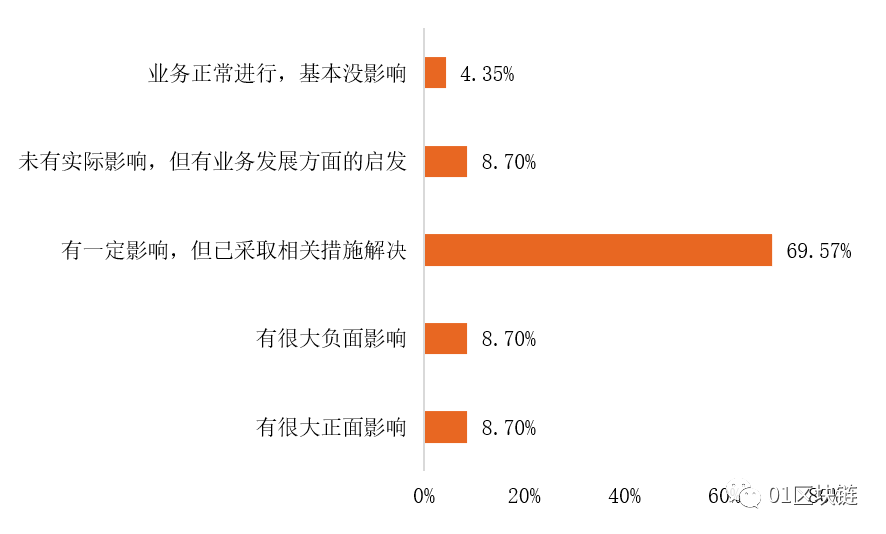
Figure 1: Impact of new crown pneumonia on blockchain companies
Source: Zero One Think Tank
According to the results of comprehensive enterprise interviews, the impact of the epidemic on blockchain companies is mainly concentrated in the short-term, and the medium- and long-term impact is limited. The main reasons are as follows:
First, the development of core businesses such as technology and product development was less affected. Blockchain companies generally operate online, and core businesses such as technology and product research and development are purely online businesses. Under the circumstances that the offline access of the entire population is blocked, online businesses can basically operate as usual. In addition, some blockchain companies have branches and branches in multiple places. “Distributed office” is the normal working state of such companies. They can flexibly respond to multi-site collaboration, cloud conferences, and online business reporting. .
Second, the epidemic has stimulated more application scenarios. The epidemic highlights the huge potential for blockchain technology to reduce costs, strengthen privacy protection, and improve social operation efficiency, which will stimulate the creation of more application scenarios. In addition, the epidemic has further stimulated the development of online business. Blockchain has the characteristics of decentralization, verifiability, and difficulty in tampering. It can effectively improve the efficiency of online business development and ensure the transparency of business development. Further increase.
Third, long-term positive policy dividends. The "1024" speech injected a "heart booster" into the development of the blockchain industry. In January 2020, the blockchain has become the focus of the work reports of local governments and has received unprecedented recognition and attention from local governments. In February 2020, the People's Bank of China issued the "Technical Specifications for Financial Distributed Ledger Technology Security." Blockchain is a typical distributed ledger technology, which provides a norm for the development of the blockchain industry. Blockchain-related applications are expected to accelerate further. .
(II) The impact is concentrated on delays in work progress and large fixed cost expenses.
The survey data shows that over 80% of the companies believe that the negative impact of the epidemic on the company is mainly concentrated in delays in work progress, large fixed costs, and obstacles to business with partner institutions.
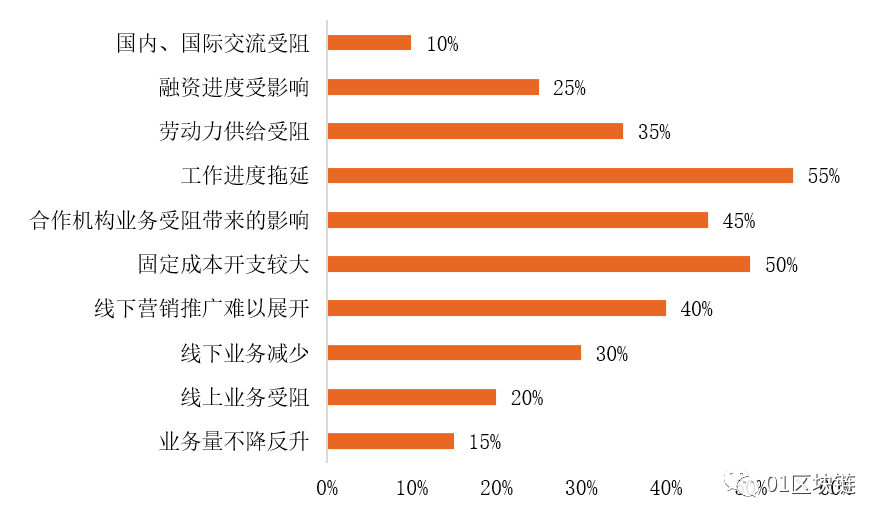
Figure 2: Impact of the epidemic on blockchain companies
Source: Zero One Think Tank
During the epidemic period, in order to prevent cross-infection and reduce the risk brought about by personnel gathering, offline business communication and promotion were blocked. Due to the difficulty of the epidemic situation in the bidding and business negotiation of previous projects, the company's business promotion plan was interrupted. As for the business that is currently communicating, due to the isolated situation of the epidemic, the enterprise cannot communicate with customers in detail about the details of the cooperation plan. The relevant content needs to be repeatedly confirmed, the communication efficiency is low, and the business is moving more slowly than usual. In addition, the later payment procedures have also been lengthened. In general, during the epidemic, the work progress of blockchain companies was delayed, which adversely affected the development of the enterprise.
At the same time, many blockchain companies are in the early stages of development, with limited capital flows and large fixed cost expenditures are also important factors affecting their development. In the case of postponed resumption of work and the obstruction of the overall work business, employees' wages, social security, taxes, and rents are all rigid expenditures, and the funding gap is large.
At present, the application scenarios of blockchain technology are more integration with traditional industries, and the cooperation agencies of blockchain enterprises are mostly traditional enterprises. Affected by the epidemic, the core demands of traditional enterprises are still to ensure the normal operation of basic production on the premise of completing epidemic prevention and control, and the demand for emerging technologies has been reduced to a certain extent. Therefore, if the epidemic impacts the traditional industry, it will inevitably affect the blockchain industry.
3. In the face of the epidemic, how can blockchain companies turn "crisis" into "opportunity"?
For the blockchain industry, the “crown outbreak” of the new crown pneumonia is both a crisis and an opportunity. How to turn the “crisis” into an “opportunity” to minimize the negative impact of the epidemic has become the company's top priority. From the survey results, it can be seen that changing employee office methods, marketing models, customer service models, and developing new products and developing new business models are the main ways that blockchain companies respond to the epidemic.

Figure 3: Blockchain companies' response to the epidemic
Source: Zero One Think Tank
(I) Carry out "distributed office" and "cloud resumption" to ensure business progress
During the epidemic, the traditional office model was blocked. In order to ensure the normal operation of the business, blockchain companies have begun a "distributed office" and "cloud resumption" model, encouraging various departments to communicate efficiently through video conferences and teleconferences, and strive for employees to stay at home. In the isolated state, keep normal work. At the same time, some companies arrange dedicated teams to care for employees, boost morale, and pay attention to their healthy working conditions.
The survey results show that although the "distributed office" online office model can largely guarantee the normal operation of the business, compared with offline office, there are still problems such as low collaboration efficiency and difficult supervision. Distance and lack of formal supervision largely depend on the consciousness of employees; at the same time, remote communication can easily lead to asymmetric information and slow work progress. The online office model leads to a decrease in overall work efficiency.
(B) change marketing models and service delivery methods
Affected by the epidemic, although most companies have launched a "distributed office" model, business cooperation has suffered greatly. At present, although the epidemic situation has been controlled to a certain extent, the problem of inefficient business environment is difficult to quickly recover, and offline communication and promotion of enterprise projects have been directly impacted. How to explore new marketing models and service delivery methods has become the biggest challenge facing all blockchain companies.
At present, most enterprises provide service through online channels. Through the use of mobile phones, computers and other equipment, using email, telephone, WeChat and other communication methods to achieve docking with customers, and strive to respond to customer needs in the first time and speed. In terms of marketing models, some blockchain companies have changed the sales promotion model of “Guangsa.com” and started focusing on mature products, focusing on key customers, striving to increase the success rate and increasing the competitiveness of their flagship products.
(3) Develop new products and launch anti-epidemic applications
Blockchain is based on the underlying structure of the Internet, and can provide technical support for credible information interaction between different industries and participants. Blockchain technology naturally meets the requirements of decentralized management, multi-party participation and traceability of epidemic prevention and control. The more complicated the process and the more participants, the greater the role of the blockchain.
In order to respond to corporate crises and contribute to the prevention and control of epidemic situations, blockchain companies have launched technical anti-epidemic and launched relevant anti-epidemic applications. During the epidemic, the anti-epidemic applications launched by institutions and organizations, including blockchain enterprises, are mainly concentrated in the fields of epidemic data monitoring, finance, charity, and medical treatment.
Table 1: Blockchain anti-epidemic applications launched by some institutions
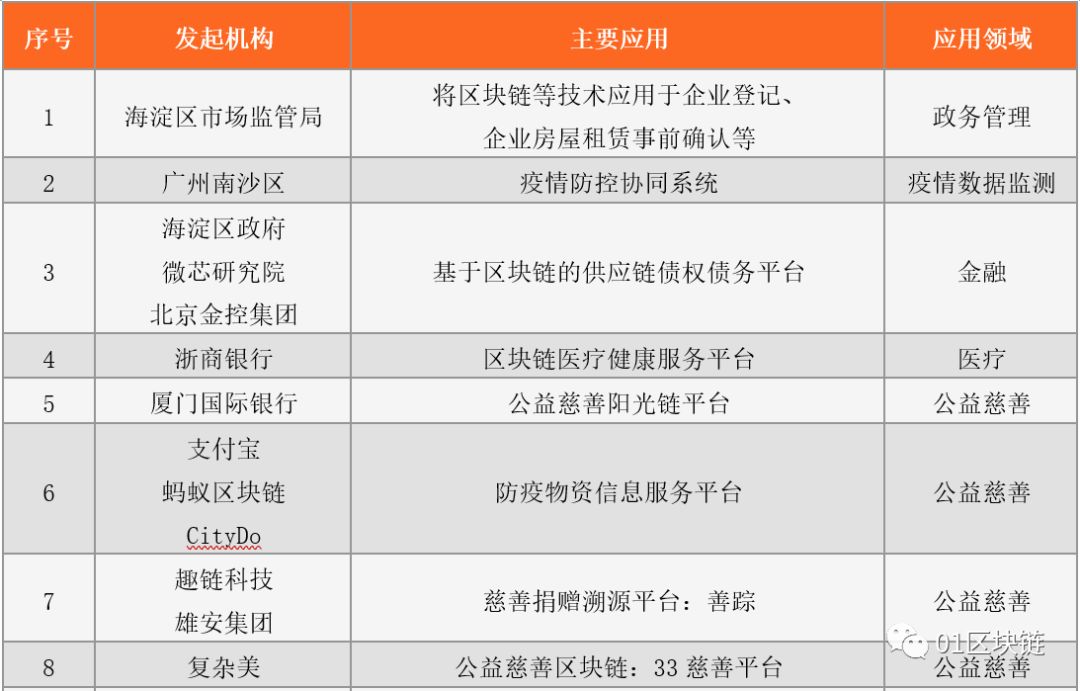

Source: Internet public information, Zero One Think Tank
But compared to artificial intelligence, big data, cloud computing and other technologies, the performance of blockchain technology in epidemic prevention and control is not eye-catching. According to the incomplete statistics of the Zero One Think Tank, during the epidemic period, artificial intelligence, big data, and cloud computing ranked among the top three among the number of information technology anti-epidemic applications. Among them, the largest number of applications of artificial intelligence were as high as 71%, while the district The number of blockchain technology applications is only 9%. [1]
In this survey, 12 of the 23 blockchain companies launched blockchain-resistant epidemic prevention applications, of which 66.67% were based on the original business transformation, 25% were temporary development, and only 8.33% Based on the original business. This shows that blockchain companies have insufficient applications in public epidemic prevention and control, and there is still much room for development.
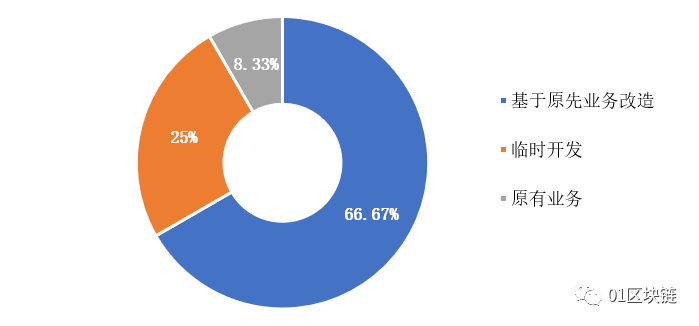
Figure 4: Anti-epidemic application development of 12 blockchain companies
Source: Zero One Think Tank
From the perspective of application effects and the scale of implementation, only 25% of the 12 applications have achieved large-scale applications. Although the remaining applications have been implemented, they have not yet been applied on a large scale or are in the beta phase. The reasons for this fact gap mainly include the development stage of the industry, the maturity of the technology itself, the application of the soil and so on:
First, the development of China's blockchain industry is still in its early stages. The value of blockchain technology has been truly faced in China, starting from the 1024 speech at the central level last year. Previously, the public's perception of blockchain was more related to "coin", and regulatory-level rectification of cryptocurrency It has also caused some restrictions on the development and application of blockchain. Limited by the attitude of the government and regulators, the industry is still not ideal in terms of the speed of development. At the time of the epidemic, it was only a few months before the blockchain technology was "rectified", and most of the application implementation work was still in its early stages, so it was difficult to have a prominent scale effect in the epidemic.
Second, the blockchain technology itself is not yet mature, and its security, scalability, and stability need to be further improved. At the same time, the industry's understanding of blockchain technology still has limitations, and the advancement of the technology cannot bring about significant gains. According to the 2019 maturity curve of blockchain technology released by Gartner, a leading global information technology research and consulting company, blockchain technology has not yet reached the mature stage. Avivah Litan, Gartner's distinguished analyst and vice president of research, also pointed out that most companies' blockchain projects are still in experimental mode. According to Gartner's prediction, blockchain technology and operations will not fully expand until 2028.
Third, the application of blockchain technology requires the cooperation of governments, financial institutions, and other parties, and it is based on the corresponding industry or field informatization transformation. At present, informatization soil in multiple domestic industries It is still immature, so there are not many areas suitable for large-scale application of blockchain technology.
Fourth, China's blockchain technology application research and development is more focused on efficiency considerations. Application research and development related to risk prevention lacks corresponding policy guidance and support, so it is relatively absent. As shown in Figure 4, in the outbreak prevention and control, more than 90% of the applications launched or planned to launch were not originally planned businesses, most of them were based on the original business transformation (66.67%) or temporary development (25 %). It can be seen that applications that are truly applicable to epidemic prevention and anti-epidemic or serve to prevent the risk of public events are not in the technology R & D planning of most enterprises.
Fifth, although the development of the blockchain industry has been affirmed from the central level, the cost of combining blockchain technology with specific scenarios to promote the application is still very high. In the absence of buyers, most of them Small and medium-sized blockchain companies have cost pressures, which has also caused a certain delay in promoting the development of the industry.
4. Under the epidemic, what new opportunities are brewing in the blockchain industry?
The epidemic prevention and control process revealed that China still needs to be improved in the response to public emergencies. Among them, the problems of poor information circulation and sharing, information asymmetry and trust are the most prominent. To solve these problems, a technology such as a blockchain with decentralization, openness and transparency, traceability, and immutability is urgently needed. Blockchain technology is essentially a distributed digital ledger, which is suitable for implementing functional requirements such as trust building, information sharing, multi-agent collaboration, and information source tracing. There is a huge scope for reducing trust costs and improving social operation efficiency. .
As mentioned above, in the prevention and control of the epidemic, the application of blockchain technology is mainly in the following four areas: epidemic data monitoring, finance, charity and medical care. Blockchain business opportunities are constantly emerging, especially non-contact, Increasing the efficiency of public services and promoting refined management, the demand for next-generation information technologies such as blockchain is increasing.
(I) Business Opportunities in the Blockchain Industry
The survey data shows that more than 80% of the interviewed companies believe that the business opportunities brought by the epidemic to the blockchain industry are mainly in the public early warning system (86.96%), followed by the traceability of materials (65.22%) and public opinion monitoring (65.22%). Information registration (52.17%) and financial services (39.13%) are also favored. In these types of applications, the role played by blockchain technology is mainly data on-chain, and the data endorsement is based on the immutable characteristics of the blockchain.

Figure 5: Business opportunities brought by the epidemic to the blockchain industry
Source: Zero One Think Tank
1. Public early warning system: timely and rapid control of epidemic situation
The current automatic early warning mechanism of infectious diseases in China is mainly composed of two parts: the database of the National Infectious Disease Surveillance Center and the automatic early warning system. Relevant data show that the early warning system basically achieves the aggregation and monitoring of data on 39 infectious diseases nationwide [2]. The new crown pneumonia epidemic prevention process has exposed the problems existing in the current national epidemic warning system, including the inefficient reporting of epidemic information data, the widespread existence of information islands between different hospitals and medical institutions, and the emergence of data source collection and entry due to human factors. Missing data. The existence of these problems resulted in untimely early warning of the epidemic and inadequate preventive measures, which exacerbated the severity of the epidemic.
After this epidemic, from the national level to all walks of life, we also realized the importance of building an efficient epidemic early warning system, and blockchain technology has opened up data silos between medical institutions, realized medical information data sharing, and improved the efficiency of epidemic information transmission. The role that can be played in this area has also received widespread attention, including governments, universities, and blockchain companies that are actively testing water-related applications.
Applications related to the public early warning system include epidemic prevention and control data collection, monitoring, and control platforms. Some blockchain companies have launched related applications in the epidemic, such as the "Outbreak Prevention and Control" launched by New World and Xunlei mentioned in Table 1. "Data Management Blockchain System" and "Blockchain Epidemic Monitoring Platform" launched by Linkfly Technology. These applications use the distributed and immutable characteristics of the blockchain, collect data at all levels, store data on the chain, and open up various levels of information exchange and invocation to achieve data tracking and management of the entire life cycle.
2. Material tracing: follow the whole chain from the source
During the new crown pneumonia epidemic, due to the inadequate disclosure of relevant information and incomplete management, charitable materials and funds were not sent to the front line in a timely manner, which had a negative impact on the epidemic prevention and the health of front-line medical staff, and also triggered the social extensive attention. At the same time, due to the inadequate supply of medical and protective materials, criminals were driven by their interests to sell fake goods, and fake products, including medical items, appeared in the workshop, which seriously threatened the lives of the people. To solve these problems, it is necessary to realize transparent sharing and efficient transmission of information on the entire process of material donation or production and sales. Based on the immutable characteristics of the blockchain, a source tracing system can be established, which not only ensures the authenticity of the data, but also ensures the security of data transmission, and can also reduce the cost.
The charity material tracing system can realize the tracing of the donated materials, and it is also convenient for the management department to carry out effective material deployment and timely supply to the places where needed. More importantly, the establishment of a credible system can eliminate the negative perceptions of charity from the high level of technology, and allow charities to better exert their social value. In responding to counterfeit goods, the characteristics of distributed storage of the blockchain are used to register drug, article manufacturers, wholesalers, terminal sales and other levels of information in the source tracing system, to achieve openness and transparency of information in auditing and tracking of inventory to ensure Compliance and security of supplies. The quality and safety of pharmaceutical products, which are related to the health and quality of life of the people, are a powerful guarantee for the normal operation of the social supply system, and also an infrastructure that is urgently needed by an increasingly developing country.
At present, related applications have been launched in the industry including Alipay, Ant Blockchain, CityDo's anti-epidemic materials information service platform, FunChain Technology and Xiong'an Group's charity donation traceability platform-Shanzun. Taking the good track as an example, with the technical characteristics of the blockchain, the platform will donate information to the chain. Once released, it cannot be tampered with and deleted, which guarantees the authenticity of the information.
3. Public opinion monitoring: build a real and credible public opinion monitoring system
With the continuous popularization of the Internet, the Internet has changed from an information dissemination platform to an opinion exchange platform. The Internet has become the main front for the generation, dissemination, and confrontation of public opinion. At present, almost all major public opinion events have been continuously amplified by the spread of the Internet.
In this epidemic, this phenomenon is particularly obvious. From the government's preventive measures in various places, to masks and other related information, there have been false news to varying degrees, such as "2019-nCoV gene fragment has artificial editing traces", "taking "Shuanghuanglian can inhibit new-style pneumonia" and other "rumored" screen swipes. This has a negative impact on the prevention and control of the epidemic and the lives of the people. The latter rumor has caused the situation of buying Shuanghuanglian oral liquid in multiple regions. Subsequently, although the relevant regulatory authorities have rumored such false information and even adopted legal measures to deter, such phenomena have been banned repeatedly.
Through the epidemic situation, the shortcomings of the public opinion monitoring system have been further amplified. At present, China's public opinion monitoring system is difficult to trace the authenticity of the information, nor can it allow the masses to verify the authenticity of the information in a timely and effective manner.
The use of blockchain technology's traceable source, difficult to tamper with, and multi-node assisted verification can create a credible and binding public opinion supervision system. This supervision system has the characteristics of diversified information nodes and irreversible dissemination process. It can achieve accurate tracking of public opinion information and improve the scientificity and predictability of public opinion research and judgment. Blockchain technology provides a new perspective for public opinion monitoring and has become a new opportunity in the eyes of blockchain companies.
4. Identity information registration: Trusted identity information management based on blockchain
Open, transparent and truthful information is very important for the effective operation of society. Especially in the face of major disasters and emergencies, people have realized the importance of information transparency and truth.
During the epidemic, in order to effectively curb the spread of the new crown pneumonia epidemic, the relevant identity information and detailed activity trajectories of confirmed patients and close contacts need to be made public. If some links are operated improperly, it is easy to cause the identity information of relevant personnel to be leaked.
In order to prevent and control the epidemic, localities also adopt closed-type management of residential quarters to control the entry and exit of personnel and to check and register. In addition, with the resumption of work and production in various places, "workers" have entered working conditions, and the number of people entering and leaving the office building has gradually increased. In order to check the epidemic situation in time, it is often necessary to register and enter the office building to fill in relevant health information. In the process of information registration, there are not only the low registration efficiency, the concentration of people, and the risk of contact infection, but also the problems of information leakage, false information filling, and “back door” access.
Issues such as information leakage and counterfeiting have always been a major problem faced by the country in carrying out related information protection work. This epidemic has further magnified this problem and made the public more aware of the seriousness of the problem. Build a trusted identity management system based on the blockchain. By uniformly registering and uploading relevant personnel information, you can track the trajectory of personnel activities and achieve accurate positioning. Using distributed identity and zero-knowledge proof technology, while ensuring the credibility of identity information, it can also prevent data leakage and ensure the security of data information.
(II) Blockchain enterprises in action
Faced with these new business opportunities, blockchain companies have shown rapid response capabilities. The survey results show that 65% of blockchain companies have adjusted their short-term strategies, and the content of the adjustment is mainly reflected in launching related applications in conjunction with epidemic prevention work , And follow-up on emerging business opportunities.
The company that adjusts the company's long-term development strategy accounts for about 22%. Among them, some companies' feedback on business impact shows that the company estimates that the business volume in the first half of the year will increase significantly due to the epidemic situation. Is online business.
Another 13% of the companies said that the company's strategy has not been adjusted due to the epidemic situation, but the evolution of the epidemic situation has also given them business inspiration. Afterwards, they will focus on new opportunities while advancing the company's original development plan, and Be prepared accordingly.
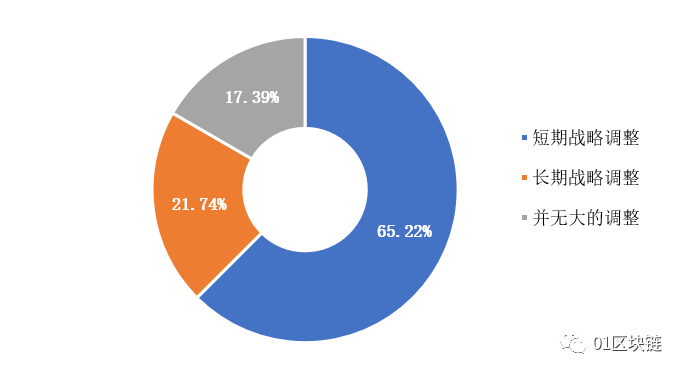
Figure 6: Impact of New Crown Pneumonia on the Development Strategy of Blockchain Enterprises
Source: Zero One Think Tank
Based on comprehensive survey and interview information, more companies tend to agree that the impact of the epidemic situation is mainly concentrated in this two months. In the long run, the policies and directions related to the industry will advance as originally expected.
V. After the baptism of the epidemic, what is the trend of the blockchain industry?
It is undeniable that there are still many unsolved problems in the development of the blockchain industry, but opportunities in the industry are also emerging, especially under the catalysis of the epidemic. Blockchain technology is used in public affairs management, social services and construction. The value of the social credit system was demonstrated. The industry view believes that, whether or not there is an epidemic, blockchain should develop technological innovation, entity integration, help social governance, and lay out a new economy.
In the field of emerging technologies, blockchain companies have shown strong action. Although the epidemic situation has not yet been completely contained, the order of social operation is gradually recovering. Because the blockchain industry is less affected, its pace of advancing against the trend is faster than more industries. Looking forward to 2020, the development trend of the blockchain industry is generally optimistic. Comprehensive survey and interview results, we have drawn the following three aspects of the industry trend outlook:
(I) The epidemic has accelerated the process of social digital construction, and the blockchain-enabled industry will accelerate
Affected by the epidemic, the demand for digital transformation in various industries and industries has generally increased. Demands arising from the development of smart cities, the upgrade of national infectious disease early warning systems, charity, and social assistance are all important scenarios for future blockchain applications. In China, digital transformation is a slogan that has been advocated by governments and enterprises in recent years, and corresponding transformation actions are also being promoted. But objectively speaking, for many companies, digital transformation is more of a bonus and has not yet become a necessary option for development. The application of digital technology in many companies has not yet involved core business, which was exposed in the epidemic Many questions have also verified this. In addition, there are many unsatisfactory aspects of the digital transformation of government departments.
The outbreak will push governments and enterprises to more actively embrace digital transformation and upgrades, and new-generation information technologies such as blockchain, artificial intelligence, and big data will also receive more attention. The pace of smart city construction will accelerate, and corresponding concepts will also Due to this epidemic situation, there will be more emphasis on technology applications and facilities in public risk management and governance during digital construction. Blockchain technology, as the basic and systemic facility of a digital society, is expected to land on a large scale in many vertical fields such as finance, supply chain, and government affairs in 2020.
(2) Deep integration of blockchain with cutting-edge technologies such as the Internet of Things, artificial intelligence and 5G
Blockchain technology itself is an integrated application that integrates a variety of technologies such as distributed data storage, encryption algorithms, consensus mechanisms, and peer-to-peer transmission. In the process of serving the digital construction of society, blockchain technology has also shown similarity with other The emerging development trends of emerging technologies such as the Internet of Things, artificial intelligence and 5G. The integration of different technologies can better complement each other's shortcomings and play a greater role. In 2019, a number of blockchain-related policies issued at the national level all mentioned the need to actively promote the integration of blockchain with information technology such as big data and artificial intelligence.
Taking the Internet of Things as an example, the development of the huge potential Internet of Things industry has been facing pain points in terms of device security, personal privacy, rigid architecture, communication compatibility, and multi-agent collaboration [3], and the combination of blockchain technology and the Internet of Things , It can well help the Internet of Things to achieve functional goals such as reduction of operation and maintenance costs, privacy protection, cross-subject collaboration, and so on. At present, leading IoT companies in the world are also deploying blockchain technology, and related industry standards are being launched one after another. Among them, in March 2017, China Unicom established the world's first product with many companies and research institutions. Networked Blockchain Standard Project, which defines a decentralized and trusted IoT service platform framework.
(3) The gradual improvement of regulatory regulations has helped the industry to further formalize
Since the 1024 speech, both at the national level and at the local level, policies for the development of the blockchain industry have been intensively introduced. Entering 2020, the introduction of relevant policies will continue unabated. In January, there were 11 national-level blockchain support policies, and the main body of policy introduction included departments from the State Council, the Central Bank, the Banking Regulatory Commission to the Ministry of Justice, the Ministry of Commerce and other departments. In February, the central and local blockchain policies related to blockchain + agriculture, service industry, factoring and other fields. As of the end of February, 22 provinces and cities have written blockchain into government work reports. After the epidemic, blockchain technology will receive more attention and larger-scale application in the real economy, and related support policies will follow. Corresponding to the development of the industry, the regulatory regulations will be more perfect, which will promote the industry to further formalize.
[1] Zero One think tank: "anti-technology" plague ": 100 Technology Applications" by: Zhao Jing, Yang Ya, Chen Cheng.
[2] 《How does blockchain technology improve the infectious disease early warning system? "Author: Zhang Xiao Hong, Huang Wenli, Lan Cheng, Zhejiang University of Finance and Economics Institute of Finance, China
[3] "block chain + Things fusion process long way to go", author: Jiang Yali.
We will continue to update Blocking; if you have any questions or suggestions, please contact us!
Was this article helpful?
93 out of 132 found this helpful
Related articles
- QKL123 market analysis | Crude oil collapses, stock indexes fall, panic spread … Bitcoin has not been spared (0309)
- The most expensive ERC-1155 NFT ever released, worth $ 102,000
- Digital wallet company Argent secures $ 12 million in Series A funding, led by well-known fund Paradigm
- Blockchain game Horizon raises $ 5 million in funding, investments including ConsenSys and DCG
- The history of the death of the most bullish fund in the history of CXC: the rebate is as high as 10, and it is now down 85%
- Or will retail demand force the SEC to approve the Bitcoin ETF?
- Former Bank of England (BoE) official: Bank of England digital currency will eventually take on many different "hybrid" forms





